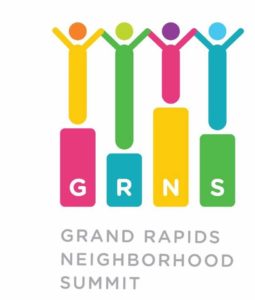Growing Justice and Community: The Grand Rapids Neighborhood Summit and Supporting Community in a Time of Crisis


 Last month, I was fortunate to have the opportunity to present at the 2020 Grand Rapids Neighborhood Summit, and, frankly, I wasn’t sure what I was walking into. My colleague, Kevin Peterson, has been a long-time attendee, and I heard about the event from him, but I was a Neighborhood Summit newbie.
Last month, I was fortunate to have the opportunity to present at the 2020 Grand Rapids Neighborhood Summit, and, frankly, I wasn’t sure what I was walking into. My colleague, Kevin Peterson, has been a long-time attendee, and I heard about the event from him, but I was a Neighborhood Summit newbie.
To my surprise, I walked into a space in which I found myself comfortable, and I could feel the comfort of others. The space was tangibly inclusive. I have never experienced anything like it. The gendered “Men” and “Women” signs for available restrooms were covered over; restrooms were gender-neutral that day. Race and racism were confronted forthrightly. It was stated at the beginning of the day that anyone breastfeeding a baby was welcome to do so whenever and wherever they pleased. Direct, explicit actions like these help to reframe the social norms in a space, putting equity at the center.
This year’s theme was “Growing Justice and Community.” Time and space were held for voices discussing climate change, environmental justice, racism, the history of American Indians in Grand Rapids, discrimination, affordable housing, and the future of our city. This was a group of people coming together who had a genuine interest in making Grand Rapids the best it can be; the most inclusive it can be; the most equitable it can be.
“This was a group of people coming together who had genuine interest in making Grand Rapids the best it can be; the most inclusive it can be; the most equitable it can be.”
Anne Marie Hertl, West Michigan Regional Coordinator with the Michigan League of Conservation Voters, spoke in the morning about environmental justice. She grounded the conversation in the 17 Environmental Justice Principles that were developed by delegates at the First National People of Color Environmental Leadership Summit in 1991, discussing the importance of considering equity when talking about climate change and environmental policies. She did an excellent job of setting the tone for the day: this would be a brave space, where your voice is welcome, and this would be a space where we consider equity, we put people first, and we consider the implications of what we say.
I had the privilege of attending two breakout sessions before hosting one of my own. I was moved by the work being done around climate change and environmental justice here in Grand Rapids and by the stories of American Indians told by Madalene Big Bear, who serves on the Anishinaabe Circle Board of Directors.
In the breakout session I led, called “Neighborhood Stats & Data,” I was honored to have the opportunity to discuss the kinds of community data that are available and how to access and utilize those data. We discussed data that are available for residents and neighborhoods to use via the Johnson Center’s Community Profiles and Community Profiles 2.0 tools and data from the City of Grand Rapids, such as the Housing NOW! Data Story Map and the Economic Opportunity Dashboard. These tools provide interactive methods for comparing information like housing, demographics, and employment in different neighborhoods around the city. It was amazing to see such a vibrant community coming together in one space for the day to discuss topics near and dear to our hearts.
The Grand Rapids Neighborhood Summit took place on March 7 and, within a week, drastic changes occurred. Michigan confirmed its first case of COVID-19, closed K–12 public schools, and banned gatherings of 250 or more people — quickly followed by the closing of restaurants and bars, and eventually a stay-at-home order just 16 days after the summit.
“I have only seen this community come closer together since we have been forced apart. In this trying time, I am consistently reminded of how seriously Grand Rapids takes its philanthropy — its love of people.”
And yet, I have only seen this community come closer together since we have been forced apart. In this trying time, I am consistently reminded of how seriously Grand Rapids takes its philanthropy — its love of people. Over the span of that same two weeks, I have seen calls for support of small business, the unemployed, the elderly, and other vulnerable populations. I have seen the community come together to feed children, donate food, donate to bands and restaurants that wouldn’t otherwise be able to make it through this time, and host a “Social Distancing Front Porch St. Patrick’s Day Happy Hour,” complete with a roaming musician.
In these times, it is easy to be selfish, to isolate, to hide from the world; the sense of community I have felt over the last few weeks has been the absolute antithesis of that. Even when we have to stay home, or at least six feet apart, Grand Rapids manages to hold our neighbors close and look out for one another, and from Neighborhood Summit to global pandemic, I am so grateful to be a part of this community.
